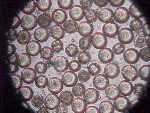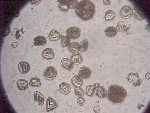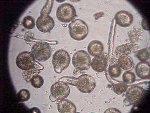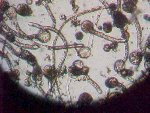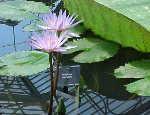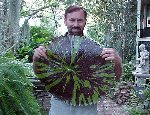Hybridizing Tropical Water Lilies
By Rich Sacher
Photos by Rich Sacher, click to enlarge
First presented at the International Waterlily and Water Gardening Society Symposium
Chicago 2000
The recipient first day flowers have had all their stamens carefully removed, and then their stigmatic fluid is also removed and discarded. Using a medicine dropper, the pollen suspension from a desired donor variety is added to the first day stigma, adding as much fluid as the stigmatic cup will hold without spilling over. A waterproof tag is tied to the flower, indicating its name, the name of the pollen being applied, and the date. You may want to tie the flower closed, so no insect can come along and add any other pollen to the stigmatic fluid which has been applied to the flower. It is interesting to note that flowers that have been pollinated will often close 3 or 4 hours earlier than other first day flowers which have not been pollinated. The following day, however, these pollinated flowers open and close at the same times as non-pollinated flowers.
A successfully pollinated flower will often develop a very strong crook in the flower stem, right below the flower, and the developing pod will often sink deep into the pond. Another sign of a successful seed pod is the fact that when the pod is examined 10 or 20 days later, by pulling back the sepals, the flower petals will be in as perfect color and condition as the day they first bloomed. (A non-pollinated flower usually rots away in 6-7 days.) If a pod is apparent 15 days after pollination, the name tag is removed from its stem and put into a zip-lock sandwich bag, and then the pod is inserted into the bag which is snugly closed around the stem. When the pod bursts, the bag floats to the surface, making it easy to see and remove from the pond.
I have also noted that sometimes viable seeds are obtained from pods which do NOT develop a crook in the stem. Even pods which seem immature when they separate from their stem may have a few viable seeds among the hundreds of immature seeds in the pod, and only careful screening and cleaning of the seeds will make this apparent.
Newly harvested water lily seeds have an aril around them which makes them float, so the seeds are stored in water and are screened and washed every day for five or six days, until the arils have rotted away and the seeds are clean and will sink to the bottom of their water jars. If you wish, the seeds may now be air dried until there is absolutely no moisture on them, and stored indefinitely in zip-lock bags at room temperature. Or, they may be stored dry in a refrigerator. They may be planted immediately by sowing them in saucers of wet, non-fertilized soil, and topped with 1/4 inch of clean sand. They are placed in clear shallow ponds which get morning sun. Germination is usually in 7 to 30 days. It may take the seedlings anywhere from 6 weeks to several months to form a rosette of underwater leaves. It may take another 6 to 12 months before they send up their first floating leaves. Plants do not need to be transplanted or fertilized until they have several small floating leaves, after which their development will be rapid if sun, warmth and nutrients are available.
Seedlings are subject to destruction by fish, snails, tadpoles and other water creatures. Seeds should be scattered very lightly across the seed pan, so they will not be crowded when they germinate. Crowding the seedlings seems to aid in "damping off".
I have stored seeds both in and out of water in a refrigerator, at 38 degrees, for as long as six months. Germination percentage was as good as seeds planted immediately after harvesting, although the refrigerated seeds took longer to germinate. If there are too many seeds from a given cross to plant at once, some of the seeds can be air dried and stored for later planting, while the remainder are planted at once.
There is some indication that not all seeds from a given pod will germinate immediately...a percentage of seeds seem to take longer to start into growth. I have also seen seedlings in the rosette stage persist for several months, and then slowly disappear...only to begin growth again months later, from small tubers that had formed at the base of their rosettes. It would be wise not to give up too quickly on a seed tray! Sometimes a gentle rinsing of the surface sand will reveal tiny seedlings which were previously hidden from view.
On some occasions, I have used pollen from two different varieties simultaneously when pollinating a flower. The resultant seeds are often a mixture of two different sizes, shapes and colors. (Theoretically, one could separate these seeds into two different groups, plant them separately, and grow out the two different hybrids.) This may be of value when one has only one plant of a desirable pod parent, but one plans to make many different crosses with it. There may be yet another reason to do this...
There may be a synergistic effect when mixing a weak pollen with a stronger one in order to get some viable seeds from the weaker pollen. I theorize that strong, rapidly germinating pollen produces hormones which cause the swelling of the ovaries, the strong crook in the seed pod stem, and the early closing of the flower, thereby supplying a "free ride" for the weaker pollen, which germinates more slowly and may not produce the necessary hormones in sufficient amounts on it own. I repeat, this is only a theory, and it needs many more trials before it can be called fact.
Cooler fall temperatures may also render the pollen of second day flowers inferior to pollen on the same flower on the third day. Under cool fall temperatures, pollen on some varieties does not seem to mature until the flower is three days old...hence the wisdom of using both a second and third day flower for a source of pollen. Also, the best way to store pollen for one or two days seems to be right on the flower, with all stamens intact. Put a second day flower into a zip-lock bag with some damp paper toweling, and the pollen stays viable for several days at room temperature. This facilitates shipping flowers across the country to supply pollen for hybridization.
If only one flower is available as a pollen donor, one can
harvest only those stamens which show pollen on the second day...and
go back to the same flower on the third day to remove the remaining
stamens for another round of hybridizations.
Pollen on some hybrids like 'Wood's Blue Goddess' is apparently sterile, and shows no germination in a one hour in vitro incubation test. Microscopic examination of this pollen shows almost no normal pollen grains, but rather all kinds of debris and aborted pollen. Not only is its pollen apparently sterile, but so seem its ovaries. Not even the most powerful pollens have ever produced a viable seed for me when crossed into Wood's Blue Goddess...even though a preliminary pod will often form and persist for 15 days or so. I have seen the same results with Midnight, another variety which produces no pollen, and which has never set seed for me. (Again, I theorize that this immature pod is regulated by the hormones produced by the rapid germination of abundant and powerful pollen grains.)
Pollen from some hybrids may have only a 10% germination rate in vitro...but can still produce seed when a concentrated suspension is used according to the method indicated above. By increasing the pollen concentration 100 fold over what usually occurs in nature, seed can be obtained from some hybrids which normally do not set seed on their own.
Some hybrids are reluctant seed setters, and sometimes numerous attempts at pollination must be done before some viable seeds are obtained. The semi-double flowered lilies fall into this category, as do some hybrids which are popular in the trade.
Finally, it is important to note that new hybrids should be grown through an entire season to properly evaluate their merits. Very often, the first flowers on a hybrid seedling are not indicative of what may follow as the plant matures. Observations to consider would include the following: Is the hybrid significantly different than named varieties already in commerce? Is it a reliable bloomer throughout the growing season? How many hours each day (or night) does the flower stay open? Does it fade or wilt badly in the summer sun? What are the flowers like in the cooler spring or fall season, as compared to full summer? Are its leaf stems flexible, or are they so brittle that the plant is easily damaged when transported? Do the flowers have a distinctive shape, color, or have more petals than other varieties? Does the flower stay open longer than the three days which are typical of tropical lilies? Is the growth habit of the plant compact, or do leaves travel far from the center of the plant? Do the leaves have distinctive markings, patterns, or shapes? If variegated, do they hold their variegation, or lose it quickly as the leaf expands? Do the leaves burn or discolor in hot summer sun? Is the hybrid easy to grow? Easy to propagate?
A lot more research needs to be done to better exploit the possibilities of developing new varieties of tropical water lilies. We should note, too, that relatively few of the world's species lilies are available in commerce, which limits the gene pool currently available for innovative hybridization.
More information is needed on the effects of temperature, day length, light intensity, growth hormones, etc., on various phases of hybridization... from pollen production, to seed set, to growing out the juvenile plants. It is hoped that these preliminary findings and suppositions will suggest fertile avenues of research for those interested in exploring the remaining unchartered waters of Nymphaea hybridization.
